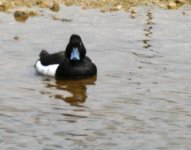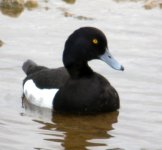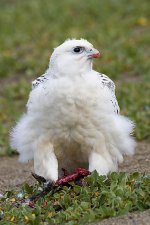glasgowbirder said:
I've noticed a few posts and a few fellow birder's saying they're going to buy a digital SLR and give up digiscoping.
How do you replicate the magnification levels acheivable by coupling a scope and camera?
Lots of good info has already been posted, and I'll throw my 2 cents in and agree with Andy that for the most part, you simply don't achieve the same magnfication levels.
(There are ways to do it though. Here is a link for some Canon lenses:
http://www.mir.com.my/rb/photography/companies/canon/fdresources/fdlenses/reflex8002000/2000mm.htm)
But even if you manage to get an equivalent focal length, you'd probably introduce issues that would begin to negate the DSLR's inherent advantage given to it by its larger sensor.
Probably the best way to do it would be with a high quality 800mm lens. The Sigma 800mm f5.6 will cost about $6000 U.S. and the 2X convert you would want would add another paltry $200. This gives you a 1600mm f11 lens which on a Canon digital camera gives you 2560mm equivalence. A better choice might be the 1.4 teleconverter which would yield a 1120mm lens at around f8 and a 1792mm equivalence. This would be at the lower end of digiscoping ranges, but I often digiscope in that range.
So it can be done. And doing it the "right" way will cost a bunch of money. but there are alternatives that will sacrifice some quality, but that may still work. You could get an inexpensive M42 mount Rubinar 1000mm f10 catadioptric for about $300. You could add a $40 2X extender and get really long at 2000mm and f22, or 3520mm equivalence. It would be better if you could hunt down a 1.4x M42 converter though. This would give you a 2240mm equivalence at around f16.
But one of the problems with a SLR and a long lens is mirror slap. These cameras simply introduce vibrations that are essentially non-existent in the little digicams that digiscopers use. You'll probably have to increase shutter speed to significantly to compensate. Digiscopers regularly get away with quite low shutter speeds that I suspect won't be useable with the DSLR. This may not be a huge burden with the expensive 800mm f5.6 lens and 1.4 converter that yields 1792mm at f8. But it gets to be a pretty big issue pretty quickly at the higher magnifications. The solution, of course is crank up the camera's ISO. But if you go up to ISO 800, the image quality becomes roughly comparable to the image quality from a digicam at ISO 100. So what have you gained for your trouble?
A digiscoping rig will typically yield much lower f-numbers at magnification ranges such as those mentioned above - between f4.5 and f6. And since the digiscoping rig has significantly lower vibration issues, it can often get away with lots lower shutter speeds. It is only in very dim light that most digiscopers find themselves bumping up the ISO.
BTW, Nikon has some vibration reduction lenses, but they don't have quite the reach of the lenses I mentioned. Another approach might be the Olympus E1. It has a smaller CCD than the other DSLRs so you can get by with a shorter focal length and consequently you get more aperture. I'd also guess its mirror is smaller and might introduce less vibration.
Then, of course, there is the whole question of image quality. I presume that a top end Canon lens and converter would yield superior image quality to a digiscoping rig. But with the 2x converter, even these lenses will be flirting with the theoretical limits of diffraction. And the lesser rigs with smaller apertures and larger f-numbers will definitley be in trouble. I'd be very surprised if these did not yield optically softer images. I've done testing with my digiscoping rigs and they can capture detail very near the limit of the sensor. Where they fall down is in image detail contrast.
So, the upshot is the more you push the DSLRs, the more likely you are to lose their quality advantage - unless you spend a LOT of money.







